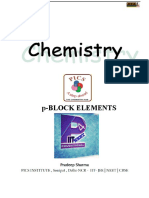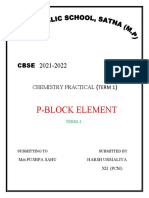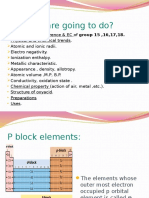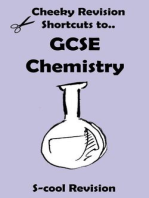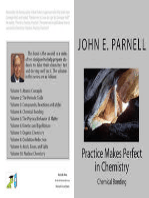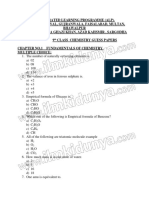0 ratings0% found this document useful (0 votes)
6 viewsP Block
P Block
Uploaded by
Mohd Hassan1. Nitrogen does not form pentahalides due to the absence of d-orbitals to extend its valency beyond four. PH3 has a lower boiling point than NH3 because nitrogen is more electronegative, leading to hydrogen bonding in NH3. NH3 acts as a Lewis base due to its lone pair of electrons.
2. NO2 dimerizes to pair up electrons and achieve octet configuration since NO2 has an odd electron. NH3 is a stronger base than PH3 due to the higher electron density on nitrogen from its smaller size. PCI3 fumes in moisture due to undergoing hydrolysis to form HCl.
3. All the five P-Cl bonds in PCI
Copyright:
© All Rights Reserved
Available Formats
Download as PDF, TXT or read online from Scribd
P Block
P Block
Uploaded by
Mohd Hassan0 ratings0% found this document useful (0 votes)
6 views23 pages1. Nitrogen does not form pentahalides due to the absence of d-orbitals to extend its valency beyond four. PH3 has a lower boiling point than NH3 because nitrogen is more electronegative, leading to hydrogen bonding in NH3. NH3 acts as a Lewis base due to its lone pair of electrons.
2. NO2 dimerizes to pair up electrons and achieve octet configuration since NO2 has an odd electron. NH3 is a stronger base than PH3 due to the higher electron density on nitrogen from its smaller size. PCI3 fumes in moisture due to undergoing hydrolysis to form HCl.
3. All the five P-Cl bonds in PCI
Original Title
p-block
Copyright
© © All Rights Reserved
Available Formats
PDF, TXT or read online from Scribd
Share this document
Did you find this document useful?
Is this content inappropriate?
1. Nitrogen does not form pentahalides due to the absence of d-orbitals to extend its valency beyond four. PH3 has a lower boiling point than NH3 because nitrogen is more electronegative, leading to hydrogen bonding in NH3. NH3 acts as a Lewis base due to its lone pair of electrons.
2. NO2 dimerizes to pair up electrons and achieve octet configuration since NO2 has an odd electron. NH3 is a stronger base than PH3 due to the higher electron density on nitrogen from its smaller size. PCI3 fumes in moisture due to undergoing hydrolysis to form HCl.
3. All the five P-Cl bonds in PCI
Copyright:
© All Rights Reserved
Available Formats
Download as PDF, TXT or read online from Scribd
Download as pdf or txt
0 ratings0% found this document useful (0 votes)
6 views23 pagesP Block
P Block
Uploaded by
Mohd Hassan1. Nitrogen does not form pentahalides due to the absence of d-orbitals to extend its valency beyond four. PH3 has a lower boiling point than NH3 because nitrogen is more electronegative, leading to hydrogen bonding in NH3. NH3 acts as a Lewis base due to its lone pair of electrons.
2. NO2 dimerizes to pair up electrons and achieve octet configuration since NO2 has an odd electron. NH3 is a stronger base than PH3 due to the higher electron density on nitrogen from its smaller size. PCI3 fumes in moisture due to undergoing hydrolysis to form HCl.
3. All the five P-Cl bonds in PCI
Copyright:
© All Rights Reserved
Available Formats
Download as PDF, TXT or read online from Scribd
Download as pdf or txt
You are on page 1of 23
1.
Nitrogen does not form pentahalide although
it exhibits a +5 oxidation state.
Due to the absence of d-orbitals N can not
extend its valency beyond four.
2. PH3 has a lower B. Point than NH3
N is more electronegative than P so in NH3 there
is intermolecular H-bonding hence it has a high
B. Point
3. NH3 acts as Lewis base
Because N has a lone pair electron so NH3 acts
as a Lewis base
4. NO2 dimerizes
NO2 has an odd electron so it dimerizes to pair
up an electron and to achieve octet configuration
5. NH3 is a stronger base than PH3
Due to the smaller size of nitrogen, there is high
electron density on nitrogen so electron pair is
easily available.
6. PCI3 fumes in moisture
PCI3 undergoes hydrolysis and gives fumes of
HCI.
" PCI3 +3 H20--> H3P03 + 3HCI
7. Allthe five P-CI bonds are not equal in PCI5
The two axial bonds suffer more repulsion from
equatorial bonds and hence are elongated.
8. H3PO2 has reducing character
Since it has two P-H bonds
9. H3PO3is dibasic (diprotic) but H3P04 is
tribasic
In H3PO3 only two H atoms are linked to 0 which
are ionizable the third H is attached to P and not
ionizable because Pis less electronegative. In
H3PO4 all the three H atoms are with O and
ionizable
10. PCI5 is ionic in solid-state
It is due to the following conversion: 2PCI5 ->
[PCI4]+[Pci6]
11. NO is paramagnetic in gaseous state but
diamagnetic in liquid and solid-state
NO(g) has an odd number of electrons so it is
paramagnetic but in the liquid and solid-state it
exists as dimmer so
there is no unpaired electron and it will be
diamagnetic
12. NCI3 hydrolyzed but NF3 does not
In NCI3 Cl has vacant d-orbitals to accept the
lone pair from H20 but in NF3 F has no d-orbitals
" NCI3 + 3H20-> NH3 +3 HOCI
13. Nitrogen shows little catenation but
phosphorous distinctly shows catenation
property
Due to the smaller size of N, there is repulsion
between the lone pairs and the N-N single bond
is weaker than P-P
14. +5 oxidation state of Biis less stable than +3
Because the inert pair effect is very prominent in
Bi, so +5 oxidation state is not stable
15. Bi in +5 oxidation state is a strong oxidizing
agent
Because inert pair effect is very prominent in Bi
so Bi5+ can be easily converted into Bi3+
16. NO(nitric oxide) becomes brown when
released into the air
It oxidizes to NO2
17.NH3 is a good complexing agent/ NH3 acts
as a ligand
It has lone pair of electrons on N-atom and can
be donated for the coordination bond.
18 Bi203 is not acidic
The size of Bi3+ is very large and so there is a
very weak +ve electric field around it so it does
not interact
with water to release H+
19. BiH3 is the strongest reducing agent among
the group-15 hydrides
Since Bi-H bond is the weakest among pr-15
hydrides so H2 gas is evolved which is reducing
20. N2 is less reactive at room temperature
Due to having a triple bond and hence high bond
dissociation energy(946 kJ/mol)
21. Bond angle in PH4+ is higher than in PH3
In PH3 there is lp-bp repulsion so the bond angle
is less whereas in PH4+ there is no lp-bp
repulsion
22. NH3 has a greater bond angle than PH3
N is more electronegative so it attracts the bond
pair electron and hence there is greater bp-bp
repulsion in
NH3 and hence greater bond angle
23. R3P=0 exists but R3N=0 does not
N due to the absence of d-orbitals can not form
prt-dr multiple bonds
24. N exists as N2 but P exists as P4
Due to its smaller size N can form prt-prt multiple
bondingand exists as a discrete N2 molecule but
P can not form prt-pr multiple bonding.
25. PCI5 can not act as areducing agent
In PCl5 P has a +5 oxidation state. P has five
valence electron in its valence shell so itcan not
increase its oxidation state beyond +5, so it can
not act as a reducing agent.
26. Phosphorous is kept under kerosene
It is highly reactive and easily catches fire due to
air oxidation
27. H3P03 is a syrupy liquid
Due to intermolecular H-bonding
28. PH3 bubbles but NH3 dissolves in water
NH3 forms H-bonding with water but PH3 can
not form so NH3 dissolves but PH3 bubbles out
29. Only a small increase in radius is observed
from As to Bi
Due to the poor shielding effect of d and f
orbitals.
30. Nitrogen is gas whereas phosphorous is
solid at room temp.
Nitrogen is a diatomic molecule having a weak
van der VWalls attraction whereas phosphorous is
tetra atomic
so it has a strongvan der Walls attraction.
31. N-N bond is weaker than P-P bond
Due to shorter bond length, there is greater
repulsion between lone pairs in N2
32. Maximum number of covalent bond formed
by N is four
Because it has three unpaired electrons and one
lone pair.
33. P205 can not be used for drying ammonia
gas.
P205 is acidic it reacts with ammonia in
presence of moisture and form (NH4)3PO4
34. NO2 is colored but its dimmer N204 is
colorless
Because NO2 has unpaired electron so it can
absorb light from VR
35. Acidity of oxyacids of nitrogen increases
with an increase in oxidation number of N
Because non-metallic character increases with
an oxidation number
36. White phosphorous is more reactive than red
phosphorous
White phosphorous consists of discrete P4
molecules which are tetrahedral so reactive but
in red phosphorous the P4 molecules are linked
in extended chain structure so it is less reactive.
37.Phophinic acid (H3P04) is monobasic /
monoprotic
Only one H atom is linked with O which is
ionizable
38. N2 has higher bond dissociation energy than
NO
Because N2 has a higher bond order
39. N2 and CO have the same bond order but Co
is more reactive
CO is a polar molecule
40. (CH3)3N is pyramidal but (SiH3)3N is planar
(CH3)3N is pyramidal due to sp3 hybridization
and one lone pair on N but (SiH3)3N is planar
due to sp2
hybridization and its lone pair is donated to
vacant d orbital of Sifor prt-dr Overlap
41. The first IE of N is greater than that of O
It is due to the half-filled and hence stable
electronic configuration of N
42. HNO2 disproportionates
In HNO2 the N is in a +3 oxidation state which
may increase as well as decrease
43. PCI5 can not act as a reducing agent
In PCI5 phosphorous is in +5 oxidation state that
is the highest oxidation state of P.
1. Group 16elemernts have lower I.E with
compare to corresponding group 15 elements
Because group 15 elements have a stable half
filled p-subshell(ns2np3) so electron can not be
removed easily
2. H2S is less acidic than H2Te
InH2Te there is lower bond energy of the H-Te
bond due to the larger size of the Te
3. H2S acts as a reducing agent while S02 acts
as both
In H2S,S has its minimum oxidation state -2
whereas in S02 it is +4 so it can be decreased up
to -2 or increased up to +6, So H2S is only
reducing but S02 is both.
4. H2S is acidic while H20 is neutral
H-S bond is weaker due to the larger size of S so
proton release easier in H2S
5. SF6 is known but SH6 does not exist
Fluorine is the strongest oxidizing agent so it can
oxidize S to its maximum Oxidation state +6, H
can not
6. Compound of F &0 is a fluoride of oxygen not
oxide of fluorine
F is more electronegative than 0
7. Scl6 is not known but SF6 is known
Fis the strongest oxidizing agent so it can
oxidize Sto its maximum oxidation state +6. Cl
can not. Again Cl
has a larger size so steric repulsion is there in
SCl6
8. SF6 is used as a gaseous electrical insulator
It is thermally stable and chemically inert
9. SF6 is not easily hydrolyzed
It is sterically protected by six F atoms hence
does not allow H20 molecules to attack the S
atom
10. S exhibits catenation properties but not Se
Due to the smaler size of S than Se. S-S bond is
much stronger than Se-Se bond
11. Sdisappears when boiled with Na2So3
It forms sodium thiosulphate.
" Na2SO3 + S -> Na2S203 (soluble)
12. H20 is liquid but H2S is gas
Ois electronegative so there is intermolecular H
bonding in water so it is liquid.
13. Ozone is a powerful oxidizing agent
It decomposes to form nascent oxygen
14. Ka2 is less than Ka1, for H2SO4 in water
The 2nd proton releases from HS04- which is
difficult. So Ka2 is less than Ka1
15. 02 is gas but sulfur is solid
Due to its smaller size Ocan form pr-pr multiple
bonds and exists as a discrete diatomic
molecule.
16. Group 16 elements are called chalcogens
Chalcogen means ore-forming elements. They
form several ores
17. Positive oxidation states of 0 are generally
not found
Due to the high electronegativity of 0
18. Thermal stability decreases from H20 to
H2Te in group 16
Due to the increase in atomic size from O to Te
the bond dissociation energy decreases
19.0 does not show +4 &+6 oxidation states
like S
Due to the absence of d-orbital in oxygen
20. The magnitude of electron gain enthalpy of
Oxygen is less than that of sulfur
Due to the very small size of 0, there is inter
electronic repulsion
21. Among the hydrides of group 16 water
shows unusualproperties
Due to H-bonding in water, the molecules get
associated
22. S exhibits catenation but not 0
Because the S-S bond is stronger than 0-O bond
23. Tendency to show -2 oxidation state
diminishes from O to Po in group 16
Due to decreases in electronegativity moving
down the group
24. 02 is paramagnetic although it has an even
number of electrons
Due presence of unpaired electrons in
antibonding molecular orbitals
25. Sulphur in vapor state exhibit
paramagnetism
In vapor stare sulfur partly exists as an S2
molecule and like 02 it has unpaired electrons in
TU* orbitals
26. SF6 is less reactive than SF4
In SF6 sulfur atom is sterically hindered due to
six F atoms
1. Halogen have maximum negative electron
gain enthalpy(AegH)
Because they have the smallest size in their
respective periods
2. F has less electron gain enthalpy than that of
Cl but fluorine is a stronger oxidizing agent than
chlorine
F has a very smal size so there is interelectronic
repulsion. F is a stronger oxidizing agent due to
its low bond
dissociation energy and high hydration energy
3. F exhibits only -1 oxidation state, other
halogen shows +1, +3, +5, +7 oxidation states
Fis a most electronegative element and due to
the absence of d-orbitals it can not expand its
octet so it does not
exhibit positive oxidation state.
4. Iron reacts with HClgives Fe(ll)chloride and
not Fe(lll)chloride
Fe + 2 HC|--->FeCl2 + H2 H2 liberated prevents
the oxidation of FeCl2 to FeCI3
5. Bond dissociation energy of F2 is less than
CI2
Due to the very small size of F, there is
interelectronic repulsion in F2 so it has low bond
5. Bond dissociation energy of F2 is less than
ci2
Due to the very small size of F, there is
interelectronic repulsion in F2 so it has low bond
dissociation energy
6. Fluorine does not undergo disproportionation
Disproportionation means simultaneous
Oxidation-reduction. F is the most
electronegative element that undergoes only
reduction but not oxidation.
7.NO dimerizes but CI20 does not
NO is odd electron species so itcompletes its
octet by dimerization
8. Bleaching by Cl2 is permanent but by S02 is
temporary
CI2 bleaches by oxidation while SO2 does it by
reduction. The reduced product gets oxidized
again in the air and the color returns
9. HF has lower acid strength than HI
Due to the larger size of , the H-l bond is weaker
than the H-F bond so HI is stronger
10. 12 is more soluble in KI than in water
12 forms complex with Kl i.e K+13
11. HCIo is a stronger acid than HIO
Clo- is more stable than l0- because Cl is more
electronegative, so HClO is stronger
12. HCI04 is a stronger acid than HCI03
CI04- is more stable than Cl03- due to more
resonance
13. OF2 should be called fluoride of oxygen and
not oxide of fluorine
Because F is more electronegative than 0
14. Interhalogens are more reactive than
halogens
They are polar
15. HF is stored in a wax-coated glass bottle
HF reacts with alkali present in the glass.
16. MF is more ionicthan MCI(M is alkali
metal)
Because F- is smaller than Cl- and hence it is less
polarisable.
17. CI2+ KI ----> brown, but excess Cl2 turns it
colorless
18. HCI04 is stronger than H2S04
Because the conjugate base Cl04- is stable due
to resonance
19. CIF3 exists but FCI3 does not
F issmaller in size and can not accommodate
three chloride ions due to steric factors.
20. HF is less volatile than HCI
In HF there is intermolecular H-bonding so the
HF molecules get associated
21. F form only one oxoacid, HOF
Due to the absence of d-orbital, it can not exhibit
higher oxidation states
22. Oform hydrogen bonding, Cl does not
O is more electronegative and smallin size than
CI
23.Halogens are colored
Due to the absorption of radiation fronm VR
24. lodine forms 13- but fluorine does not form
F3
Due to the small size of fluorine
25. HIcan not be prepared by heating KIwith
conc. H2S04
26. The magnitude of electron gain enthalpy of F
is less than that of CI
Due to the very smallsize of F, there is inter
electronic repulsion.
27. Fluorine is a stronger oxidizing agent than
chlorine though it has lower electron gain
enthalpy
Fluorine has a higher reduction potentialvalue
due to its low bond dissociation energy andhigh
hydration
energy compare to chlorine.
28. Acid strength increases in the order HF< HCI
<HBr < HI
As size increases from F to Clthe bond
dissociation energy decreases from HF to HI
1. He, Ne do not form a compound with F
Due to high IE
2. Noble gases have very low Boiling Point
Because there is only a weak dispersion force
between their atoms.
3. Hydrolysis of XeF6 is nota redox reaction
Because in the products formed XeOF4 and
Xe02F2 the Xe has the same oxidation state (+6)
as in XeF6
4. Ne used as a warning signal
Because Ne - light has high fog penetration
power
5. Noble gases form compounds only with
fluorine and oxygen
Because F&0 are the most electronegative
elements
6. Xe does not form XeF3 or XeF5
Xe has all paired electrons so promotion of one,
two, or three electrons will give rise to two, four,
or six
unpaired electrons hence can not form XeF3 and
XeF5
7. Out of noble gases only Xe forms compounds
Because Xe has comparatively low IE and vacant
orbitals for promotion of electrons
8. Noble gases are mostly inert
Because they have filled valence orbitals i.e octet
configuration
9. He is used as diving apparatus
Because it is less soluble in blood compare to
nitrogen
10. It is difficult to study the chemistry of Rn
Because Rn is radioactive and hence very
unstable
11. Noble gases have comparatively large
atomic size
They are monoatomic so their Van der Walls radii
measured which is longer than covalent/ionic or
metallic radii.
You might also like
- Simulation BondingDocument12 pagesSimulation BondingCristina Nicomedes Aguinaldo0% (2)
- Exp 5 Alk Earth Metals Halogens Fall 2013Document19 pagesExp 5 Alk Earth Metals Halogens Fall 2013vikram622100% (1)
- P-D Reasoning Questions AnswersDocument4 pagesP-D Reasoning Questions AnswersGarvit GandhiNo ratings yet
- 15TH Group ElementsDocument8 pages15TH Group ElementsredoxreactionsNo ratings yet
- 7.the P-Block Elements - Group 15 Elements: Group 15 Includes Nitrogen, Phosphorus, Arsenic, Antimony and BismuthDocument10 pages7.the P-Block Elements - Group 15 Elements: Group 15 Includes Nitrogen, Phosphorus, Arsenic, Antimony and BismuthtayaNo ratings yet
- 7.p Block Elements NewDocument22 pages7.p Block Elements NewMehak GandhiNo ratings yet
- NCERT Solutions Class 12 Chemistry Chapter 7 P Block ElementsDocument17 pagesNCERT Solutions Class 12 Chemistry Chapter 7 P Block ElementsVidyakulNo ratings yet
- Chem Quiz 3Document13 pagesChem Quiz 3Gaurav ShekharNo ratings yet
- Some More QuestionsDocument18 pagesSome More QuestionsGauravNo ratings yet
- Nitrogen Family Study NotesDocument61 pagesNitrogen Family Study NotesBelezza CoNo ratings yet
- Chapter 7 The P Block ElementsDocument14 pagesChapter 7 The P Block ElementsNAVEEN BUNKARNo ratings yet
- Chemistry P Block ElementsDocument14 pagesChemistry P Block ElementsSurendra Tyagi0% (1)
- Reasoning Questions in P Block ElementsDocument15 pagesReasoning Questions in P Block ElementsAbhi WaliaNo ratings yet
- Chapter 7 11Document34 pagesChapter 7 11Ritik KumarNo ratings yet
- P Block Elements Notes For Entrance ExaminationDocument13 pagesP Block Elements Notes For Entrance ExaminationSrijan ChakrabortyNo ratings yet
- P Block ElementsDocument35 pagesP Block ElementsParth ShuklaNo ratings yet
- Chapter 7 Chemistry Class 12_Formula_SheetDocument8 pagesChapter 7 Chemistry Class 12_Formula_SheetmayankmatrybhatiaNo ratings yet
- P - Block Reasoning 16, 17, 18 Very Simplified - (1) FDocument9 pagesP - Block Reasoning 16, 17, 18 Very Simplified - (1) FShazia FarheenNo ratings yet
- UPDATED PBlock ElementsDocument100 pagesUPDATED PBlock ElementsAarohi SharmaNo ratings yet
- P-Block Element: Chemistry Practical (Term 1)Document14 pagesP-Block Element: Chemistry Practical (Term 1)Siddhant BaghelNo ratings yet
- P Block Elements 01Document23 pagesP Block Elements 01Hussain AbbasNo ratings yet
- XII - The P-Block ElementsDocument6 pagesXII - The P-Block ElementsRanjan BhatNo ratings yet
- 8 P Block FullDocument17 pages8 P Block Fullaleena'No ratings yet
- P Block Give Reasons (Without Answers)Document6 pagesP Block Give Reasons (Without Answers)zxcvb100% (1)
- Basic Concepts P-Block Class 12Document26 pagesBasic Concepts P-Block Class 12gomathi_nellaiNo ratings yet
- CBSE Class 12 Chem Notes Question Block Elements PDFDocument28 pagesCBSE Class 12 Chem Notes Question Block Elements PDFThiru98No ratings yet
- Notes On P-Block ElementsDocument14 pagesNotes On P-Block ElementscurioeNo ratings yet
- P BlockDocument28 pagesP BlockKamalpreet SinghNo ratings yet
- Anomalies of Non MetalsDocument21 pagesAnomalies of Non MetalsaziahmughalNo ratings yet
- NCERT Solutions Chemistry Class XIDocument28 pagesNCERT Solutions Chemistry Class XIGabriel BandaNo ratings yet
- Chapter 7 The P Block ElementsDocument25 pagesChapter 7 The P Block Elementspriyanka kNo ratings yet
- The P-Block Elements (Summary)Document49 pagesThe P-Block Elements (Summary)nickan876No ratings yet
- P Bond Question AnswersDocument10 pagesP Bond Question Answerszkcps8zcktNo ratings yet
- Chemistry 11th N&O FamilyDocument58 pagesChemistry 11th N&O FamilySJAIN12No ratings yet
- Solution - Assignment P BLOCK ELEMENTSDocument4 pagesSolution - Assignment P BLOCK ELEMENTSYash KumarNo ratings yet
- Zam P BLOCK NW 4Document212 pagesZam P BLOCK NW 4mrrsiddiquiNo ratings yet
- NitrogenDocument58 pagesNitrogenPriyansh Mishra100% (2)
- 7 P Block Elements 1.pptxDocument54 pages7 P Block Elements 1.pptxAmita RajputNo ratings yet
- Carbon FamilyDocument33 pagesCarbon Familyk narayanaraoNo ratings yet
- 10+2 Chem P-Block ElementsDocument44 pages10+2 Chem P-Block ElementsArjun PasrichaNo ratings yet
- Class 12 P Block SNDocument10 pagesClass 12 P Block SN09 Krishna TrivediNo ratings yet
- Inorganic ChemistryDocument13 pagesInorganic Chemistrybhargavthegreat123No ratings yet
- CHEMISTRY OF THE REPRESENTATIVE ELEMENTS-II Mid Q & ADocument13 pagesCHEMISTRY OF THE REPRESENTATIVE ELEMENTS-II Mid Q & AAflatur SafaNo ratings yet
- THE P - Block Elements-Anil-Hsslive PDFDocument19 pagesTHE P - Block Elements-Anil-Hsslive PDFKochuzNo ratings yet
- Lock Roup: Chapter-1Document42 pagesLock Roup: Chapter-1Binod TharuNo ratings yet
- Chem 1101 - Chemistry and Periodicity of GP 15 Elements: VseprDocument16 pagesChem 1101 - Chemistry and Periodicity of GP 15 Elements: VseprNicholas OwNo ratings yet
- 16th GroupDocument27 pages16th GroupSai Sasivardhan GampaNo ratings yet
- 7 P Block Elements 3.PptxDocument38 pages7 P Block Elements 3.PptxAmita RajputNo ratings yet
- P Block Elements Group 15Document79 pagesP Block Elements Group 1515 Kabir Sharma 10 HNo ratings yet
- P Block ChemistryDocument7 pagesP Block ChemistryNcnagesh PrasadNo ratings yet
- 12 Chemistry NcertSolutions Chapter 7 Exercises PDFDocument17 pages12 Chemistry NcertSolutions Chapter 7 Exercises PDFDeepak YadavNo ratings yet
- Document (2) 1-1Document6 pagesDocument (2) 1-1malaysiamailidNo ratings yet
- Chemistry Cheat Sheet - Physical and Chemical PropertiesDocument5 pagesChemistry Cheat Sheet - Physical and Chemical PropertiesEdward LeeNo ratings yet
- D and F Study MaterialDocument5 pagesD and F Study MaterialxxcosmozerxxNo ratings yet
- Isc Previous Year Question AnswerDocument4 pagesIsc Previous Year Question Answersambitghosh2006No ratings yet
- Nitrogen FamilyDocument33 pagesNitrogen FamilyArpit PatelNo ratings yet
- GCSE Chemistry Revision: Cheeky Revision ShortcutsFrom EverandGCSE Chemistry Revision: Cheeky Revision ShortcutsRating: 4.5 out of 5 stars4.5/5 (3)
- Advances in Organometallic Chemistry and Catalysis: The Silver / Gold Jubilee International Conference on Organometallic Chemistry Celebratory BookFrom EverandAdvances in Organometallic Chemistry and Catalysis: The Silver / Gold Jubilee International Conference on Organometallic Chemistry Celebratory BookArmando J. L. PombeiroRating: 5 out of 5 stars5/5 (1)
- Practice Makes Perfect in Chemistry: Chemical BondingFrom EverandPractice Makes Perfect in Chemistry: Chemical BondingRating: 5 out of 5 stars5/5 (3)
- Practice Makes Perfect in Chemistry: The Periodic Table with AnswersFrom EverandPractice Makes Perfect in Chemistry: The Periodic Table with AnswersRating: 5 out of 5 stars5/5 (1)
- Forces Between Atoms and MoleculesDocument13 pagesForces Between Atoms and MoleculesDoc_CrocNo ratings yet
- Chemistry Chapter 6 ReviewDocument4 pagesChemistry Chapter 6 ReviewSirena GutierrezNo ratings yet
- ELP-1 To 4 - IIT-Growth - Periodic TableDocument8 pagesELP-1 To 4 - IIT-Growth - Periodic TablekittukookyNo ratings yet
- Chemistry, 7-8-6Document25 pagesChemistry, 7-8-6Kissha TayagNo ratings yet
- Electronegativity-Polarity and Chemical BondDocument24 pagesElectronegativity-Polarity and Chemical BondDn AngelNo ratings yet
- CHM131 - CH 3 - The Electronic Structure of Atoms and Periodic Table PDFDocument102 pagesCHM131 - CH 3 - The Electronic Structure of Atoms and Periodic Table PDFRabiatul Adawiyyah100% (1)
- 9TH Class Chemistry Guess PaperDocument11 pages9TH Class Chemistry Guess PaperMarkpiciNo ratings yet
- Final Exam PHYSICAL SCIENCEDocument3 pagesFinal Exam PHYSICAL SCIENCEarniel catubigNo ratings yet
- AS Chemistry EdexcelDocument47 pagesAS Chemistry EdexcelLakindu LiyanageNo ratings yet
- IB Chemistry SL and HL Topic 3 Booklet 1Document21 pagesIB Chemistry SL and HL Topic 3 Booklet 1hansenli1357No ratings yet
- Dokumen - Tips Organic Chemistry An Acid Base Approach Second EditionDocument333 pagesDokumen - Tips Organic Chemistry An Acid Base Approach Second EditionQuoc AnhNo ratings yet
- Classification of Elements and Periodicity in Properties DPP 9Document3 pagesClassification of Elements and Periodicity in Properties DPP 9jatinkaushal1416No ratings yet
- Sir Zain NotesDocument255 pagesSir Zain Notesim.faisalibrahimNo ratings yet
- Lesson 03 - Physical ScienceDocument22 pagesLesson 03 - Physical ScienceAngelo Freidrich O AmbalongNo ratings yet
- Science 9 Quiz# 1 2nd QDocument3 pagesScience 9 Quiz# 1 2nd QEmmanuel LlonaNo ratings yet
- An Extended Model of The S 2 Reaction Between A Substituted Alkane and NucleophileDocument10 pagesAn Extended Model of The S 2 Reaction Between A Substituted Alkane and NucleophileSubhabrata MabhaiNo ratings yet
- DLL Grade 9 Matter 2nd Quarterpdf PDF FreeDocument44 pagesDLL Grade 9 Matter 2nd Quarterpdf PDF FreeJeshiel MNo ratings yet
- CHEMISTRY TOPIC 3 TrendsDocument3 pagesCHEMISTRY TOPIC 3 TrendsAisy BalalaNo ratings yet
- Science Golden Sample PPRDocument67 pagesScience Golden Sample PPRMaHaJaN TaNyANo ratings yet
- P Block Group 16 - PDFDocument29 pagesP Block Group 16 - PDFlenovolaptop2342132No ratings yet
- Periodic Classification Revision QuestionsDocument6 pagesPeriodic Classification Revision QuestionsSumiNo ratings yet
- Gened FinalDocument90 pagesGened FinalAnonymous V6406z6P2No ratings yet
- ALL Lesson 3m and 5 Marks 10m KALVISOLAIDocument21 pagesALL Lesson 3m and 5 Marks 10m KALVISOLAISivaRajiNo ratings yet
- Chemistry XI Part-1Document26 pagesChemistry XI Part-1Janki VernekarNo ratings yet
- Chemical Bonding and Molecular StructureDocument30 pagesChemical Bonding and Molecular StructureXenon Classes100% (1)
- Instant Download (Ebook PDF) Chemistry The Central Science 13th Global Edition PDF All ChaptersDocument25 pagesInstant Download (Ebook PDF) Chemistry The Central Science 13th Global Edition PDF All Chaptersfouaniosaro100% (5)
- Division of Elements Into S, P, D and F BlocksDocument9 pagesDivision of Elements Into S, P, D and F BlocksDASHRATH SINGHNo ratings yet
- Matching: Match Each Item With The Correct Statement BelowDocument16 pagesMatching: Match Each Item With The Correct Statement BelowwallaNo ratings yet















